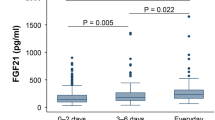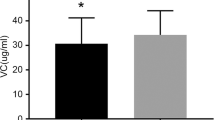Abstract
Background/objectives:
Circulating selenoprotein P (SeP), fibroblast growth factor (FGF) 21 and FGF23 have been associated with metabolic syndrome (MetS) in adults but not in children. We sought to evaluate the association among SeP, FGF21, FGF23 and MetS in young children.
Subjects/methods:
A cross-sectional study conducted during a school health examination on 210 children aged 9 years. We measured serum SeP, FGF21 and FGF23 levels, and assessed anthropometric and cardiometabolic variables. MetS was defined as the presence of ⩾3 of the following five criteria: high blood pressure, low high-density lipoprotein cholesterol (HDL-C), high triglyceride, high fasting glucose and abdominal obesity.
Results:
SeP was correlated positively with HDL-C and negatively with body mass index, waist circumference (WC), blood pressure, transaminases, triglyceride and homeostasis model assessment of insulin resistance (HOMA-IR). FGF21 was directly correlated with WC, triglyceride and HOMA-IR, and FGF23 was inversely correlated with fasting glucose and alanine aminotransferase. Children with MetS had lower SeP and FGF23 levels and higher HOMA-IR than children without MetS. The highest tertile of SeP had decreased odds for MetS (odds ratio 0.05, 95% confidence interval (CI) 0.00–0.96, P for trend=0.042), whereas FGF21 and FGF23 did not relate to the risk for MetS after controlling for confounders.
Conclusions:
Elevated SeP concentrations are independently associated with a reduced risk of MetS in children. The associations between FGF21, FGF23 and metabolic parameters are not of comparable significance.
This is a preview of subscription content, access via your institution
Access options
Subscribe to this journal
Receive 12 print issues and online access
$259.00 per year
only $21.58 per issue
Buy this article
- Purchase on SpringerLink
- Instant access to full article PDF
Prices may be subject to local taxes which are calculated during checkout
Similar content being viewed by others
References
Balkau B, Charles MA . Comment on the provisional report from the WHO consultation. European Group for the Study of Insulin Resistance (EGIR). Diabet Med 1999; 16: 442–443.
Wu SH, Liu Z, Ho SC . Metabolic syndrome and all-cause mortality: a meta-analysis of prospective cohort studies. Eur J Epidemiol 2010; 25: 375–384.
Mottillo S, Filion KB, Genest J, Joseph L, Pilote L, Poirier P et al. The metabolic syndrome and cardiovascular risk a systematic review and meta-analysis. J Am Coll Cardiol 2010; 56: 1113–1132.
Tailor AM, Peeters PH, Norat T, Vineis P, Romaguera D . An update on the prevalence of the metabolic syndrome in children and adolescents. Int J Pediatr Obes 2010; 5: 202–213.
Berenson GS, Srinivasan SR, Bao W, Newman WP 3rd, Tracy RE, Wattigney WA . Association between multiple cardiovascular risk factors and atherosclerosis in children and young adults. The Bogalusa Heart Study. N Engl J Med 1998; 338: 1650–1656.
Iannuzzi A, Licenziati MR, Acampora C, Renis M, Agrusta M, Romano L et al. Carotid artery stiffness in obese children with the metabolic syndrome. Am J Cardiol 2006; 97: 528–531.
Chen W, Srinivasan SR, Li S, Xu J, Berenson GS . Metabolic syndrome variables at low levels in childhood are beneficially associated with adulthood cardiovascular risk: the Bogalusa Heart Study. Diabetes Care 2005; 28: 126–131.
Burk RF, Hill KE, Motley AK . Plasma selenium in specific and non-specific forms. Biofactors 2001; 14: 107–114.
Akesson B, Bellew T, Burk RF . Purification of selenoprotein P from human plasma. Biochim Biophys Acta 1994; 1204: 243–249.
Burk RF, Hill KE . Selenoprotein P: an extracellular protein with unique physical characteristics and a role in selenium homeostasis. Annu Rev Nutr 2005; 25: 215–235.
Misu H, Takamura T, Takayama H, Hayashi H, Matsuzawa-Nagata N, Kurita S et al. A liver-derived secretory protein, selenoprotein P, causes insulin resistance. Cell Metab 2010; 12: 483–495.
Yang SJ, Hwang SY, Choi HY, Yoo HJ, Seo JA, Kim SG et al. Serum selenoprotein P levels in patients with type 2 diabetes and prediabetes: implications for insulin resistance, inflammation, and atherosclerosis. J Clin Endocrinol Metab 2011; 96: E1325–E1329.
Speckmann B, Walter PL, Alili L, Reinehr R, Sies H, Klotz LO et al. Selenoprotein P expression is controlled through interaction of the coactivator PGC-1alpha with FoxO1a and hepatocyte nuclear factor 4alpha transcription factors. Hepatology 2008; 48: 1998–2006.
Jackson MI, Cao J, Zeng H, Uthus E, Combs GF Jr S-adenosylmethionine-dependent protein methylation is required for expression of selenoprotein P and gluconeogenic enzymes in HepG2 human hepatocytes. J Biol Chem 2012; 287: 36455–36464.
Beenken A, Mohammadi M . The FGF family: biology, pathophysiology and therapy. Nat Rev Drug Discov 2009; 8: 235–253.
Kralisch S, Fasshauer M . Fibroblast growth factor 21: effects on carbohydrate and lipid metabolism in health and disease. Curr Opin Clin Nutr Metab Care 2011; 14: 354–359.
Angelin B, Larsson TE, Rudling M . Circulating fibroblast growth factors as metabolic regulators—a critical appraisal. Cell Metab 2012; 16: 693–705.
Reinehr T, Woelfle J, Wunsch R, Roth CL . Fibroblast growth factor 21 (FGF-21) and its relation to obesity, metabolic syndrome, and nonalcoholic fatty liver in children: a longitudinal analysis. J Clin Endocrinol Metab 2012; 97: 2143–2150.
Mirza MA, Alsio J, Hammarstedt A, Erben RG, Michaelsson K, Tivesten A et al. Circulating fibroblast growth factor-23 is associated with fat mass and dyslipidemia in two independent cohorts of elderly individuals. Arterioscler Thromb Vasc Biol 2011; 31: 219–227.
Wojcik M, Dolezal-Oltarzewska K, Janus D, Drozdz D, Sztefko K, Starzyk JB . FGF23 contributes to insulin sensitivity in obese adolescents—preliminary results. Clin Endocrinol 2012; 77: 537–540.
Choi KM, Yannakoulia M, Park MS, Cho GJ, Kim JH, Lee SH et al. Serum adipocyte fatty acid-binding protein, retinol-binding protein 4, and adiponectin concentrations in relation to the development of the metabolic syndrome in Korean boys: a 3-y prospective cohort study. Am J Clin Nutr 2011; 93: 19–26.
Wallace TM, Levy JC, Matthews DR . Use and abuse of HOMA modeling. Diabetes Care 2004; 27: 1487–1495.
Cook S, Weitzman M, Auinger P, Nguyen M, Dietz WH . Prevalence of a metabolic syndrome phenotype in adolescents: findings from the third National Health and Nutrition Examination Survey, 1988-1994. Arch Pediatr Adolesc Med 2003; 157: 821–827.
Committee on Health and Statistics, Korean Pediatrics Society. Korean physical growth standards for children and adolescents. Korean Pediatrics Society: Seoul, Korea, 2007.
Kabuyama Y, Oshima K, Kitamura T, Homma M, Yamaki J, Munakata M et al. Involvement of selenoprotein P in the regulation of redox balance and myofibroblast viability in idiopathic pulmonary fibrosis. Genes Cells 2007; 12: 1235–1244.
Steinbrenner H, Alili L, Bilgic E, Sies H, Brenneisen P . Involvement of selenoprotein P in protection of human astrocytes from oxidative damage. Free Radic Biol Med 2006; 40: 1513–1523.
Zhang Y, Chen X . Reducing selenoprotein P expression suppresses adipocyte differentiation as a result of increased preadipocyte inflammation. Am J Physiol Endocrinol Metab 2011; 300: E77–E85.
Stranges S, Marshall JR, Natarajan R, Donahue RP, Trevisan M, Combs GF et al. Effects of long-term selenium supplementation on the incidence of type 2 diabetes: a randomized trial. Ann Intern Med 2007; 147: 217–223.
Klein EA, Thompson IM Jr, Tangen CM, Crowley JJ, Lucia MS, Goodman PJ et al. Vitamin E and the risk of prostate cancer: the Selenium and Vitamin E Cancer Prevention Trial (SELECT). JAMA 2011; 306: 1549–1556.
Ezaki O . The insulin-like effects of selenate in rat adipocytes. J Biol Chem 1990; 265: 1124–1128.
Labunskyy VM, Lee BC, Handy DE, Loscalzo J, Hatfield DL, Gladyshev VN . Both maximal expression of selenoproteins and selenoprotein deficiency can promote development of type 2 diabetes-like phenotype in mice. Antioxid Redox Signal 2011; 14: 2327–2336.
Rayman MP, Stranges S . Epidemiology of selenium and type 2 diabetes: Can we make sense of it? Free Radic Biol Med 2013; 65: 1557–1564.
Choi HY, Hwang SY, Lee CH, Hong HC, Yang SJ, Yoo HJ et al. Increased selenoprotein p levels in subjects with visceral obesity and nonalcoholic fatty liver disease. Diabetes Metab J 2013; 37: 63–71.
Mao J, Teng W . The relationship between selenoprotein P and glucose metabolism in experimental studies. Nutrients 2013; 5: 1937–1948.
Choi Y, Kim J, Lee H-S, Kim C-i, Hwang IK, Park HK et al. Selenium content in representative Korean foods. J Food Compost Anal 2009; 22: 117–122.
Fisher FM, Chui PC, Antonellis PJ, Bina HA, Kharitonenkov A, Flier JS et al. Obesity is a fibroblast growth factor 21 (FGF21)-resistant state. Diabetes 2010; 59: 2781–2789.
Zhang X, Yeung DC, Karpisek M, Stejskal D, Zhou ZG, Liu F et al. Serum FGF21 levels are increased in obesity and are independently associated with the metabolic syndrome in humans. Diabetes 2008; 57: 1246–1253.
Srinivasan SR, Frontini MG, Berenson GS . Longitudinal changes in risk variables of insulin resistance syndrome from childhood to young adulthood in offspring of parents with type 2 diabetes: the Bogalusa Heart Study. Metabolism 2003; 52: 443–450.
Hesse M, Frohlich LF, Zeitz U, Lanske B, Erben RG . Ablation of vitamin D signaling rescues bone, mineral, and glucose homeostasis in Fgf-23 deficient mice. Matrix Biol 2007; 26: 75–84.
Majumdar V, Christopher R . Association of exonic variants of Klotho with metabolic syndrome in Asian Indians. Clin Chim Acta 2011; 412: 1116–1121.
Streicher C, Zeitz U, Andrukhova O, Rupprecht A, Pohl E, Larsson TE et al. Long-term Fgf23 deficiency does not influence aging, glucose homeostasis, or fat metabolism in mice with a nonfunctioning vitamin D receptor. Endocrinology 2012; 153: 1795–1805.
Acknowledgements
This research was supported by the Basic Science Research Program through the National Research Foundation of Korea (NRF) and funded by the Ministry of Education, Science, and Technology (2012–004869).
AUTHOR CONTRIBUTIONS
B-JK, SMK, HSP and CSM designed the study, analyzed the data, interpreted the data and wrote the first draft of the paper. B-JK, SMK, KHP, HSP and CSM contributed to the writing of the manuscript, the interpretation of data and critical revision of the manuscript; they were also involved in study recruitment and acquisition of the data. All authors were involved in writing and reviewing the manuscript, and all authors have approved the final manuscript.
Author information
Authors and Affiliations
Corresponding authors
Ethics declarations
Competing interests
The authors declare no conflict of interest.
Rights and permissions
About this article
Cite this article
Ko, BJ., Kim, S., Park, K. et al. Levels of circulating selenoprotein P, fibroblast growth factor (FGF) 21 and FGF23 in relation to the metabolic syndrome in young children. Int J Obes 38, 1497–1502 (2014). https://doi.org/10.1038/ijo.2014.45
Received:
Revised:
Accepted:
Published:
Issue date:
DOI: https://doi.org/10.1038/ijo.2014.45
Keywords
This article is cited by
-
Dietary pattern associated with selenoprotein P and MRI-derived body fat volumes, liver signal intensity, and metabolic disorders
European Journal of Nutrition (2019)
-
Metabolomics signature associated with circulating serum selenoprotein P levels
Endocrine (2019)
-
Serum selenoprotein P, but not selenium, predicts future hyperglycemia in a general Japanese population
Scientific Reports (2018)
-
Hepatokines: linking nonalcoholic fatty liver disease and insulin resistance
Nature Reviews Endocrinology (2017)
-
Longitudinal Changes in Serum Levels of Angiopoietin-Like Protein 6 and Selenoprotein P After Gastric Bypass Surgery
Obesity Surgery (2016)



